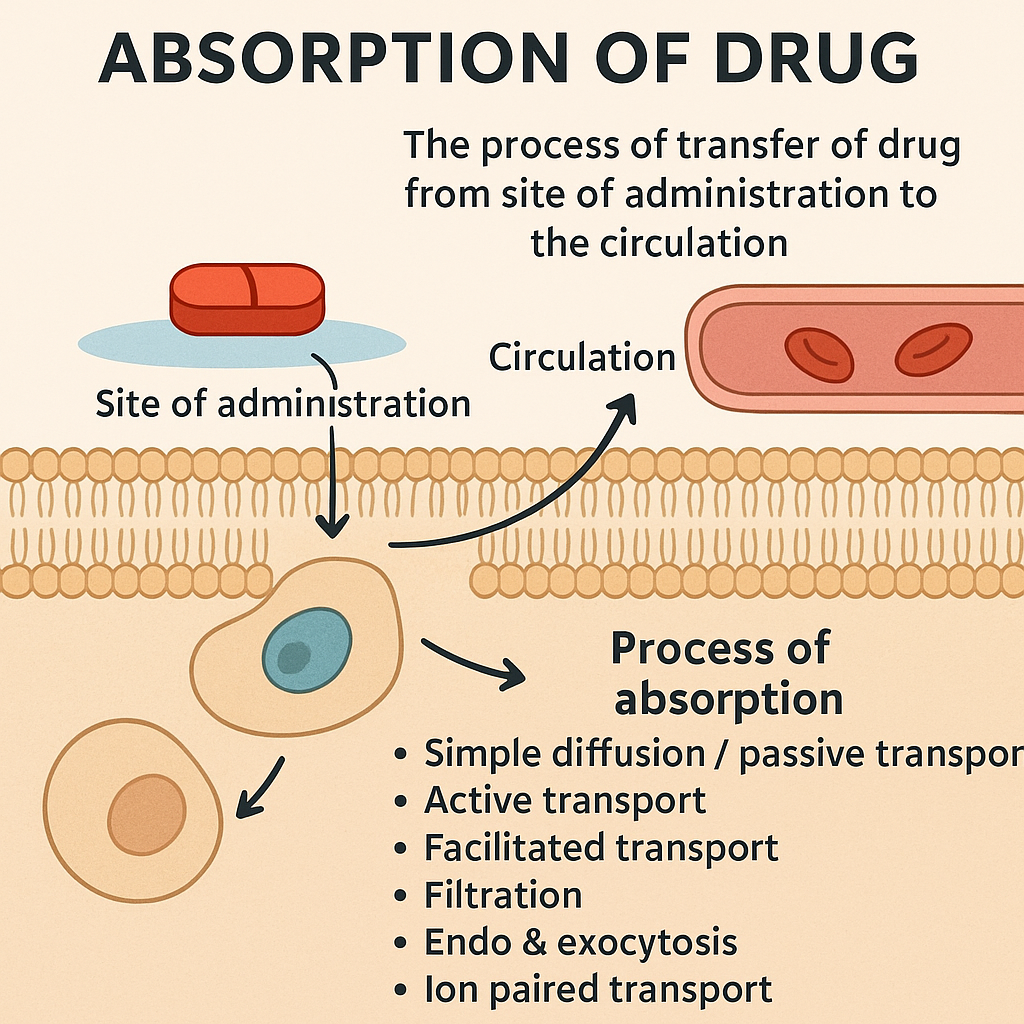Absorption of Drug: 7 Key Factors That Boost or Block Effectiveness

7 Major Factors Affecting Absorption of Drug
Absorption:
The process of transfer of drug from site of administration to the circulation.
Key points
- Drugs have to cross cell membrane to reach the circulation.
- It should be lipid soluble, non polar, non ionized.
- Water soluble substances can`t cross through lipid layer.
- Protein molecules contain channels through which small MW water soluble particles can cross.
Process of absorption
- Simple diffusion / passive transport
- Active transport
- Facilitated transport
- Filtration
- Endo & exocytosis
- Ion paired transport
Passive/Simple transport
Definition: Drug moves from higher to lower concentration
Criteria:
- From higher to lower concen. (along concen. gradient)
- Energy & carrier not needed.
- most drugs use this process.
Example
- aspirin
- morphine
- Pethidine
- Barbiturates
- sulfonamides
Active transport
Definition: Drugs move from lower to higher concentration with the help of carrier & energy.
Criteria:
- From lower to higher concen. (against concen. gradient)
- Energy & carrier needed
- Few drugs use this process
- (least common )
- Very quick process
Example:
- iron
- levodopa
- α methyldopa
- 5-fluorouracil
- 5-bromouracil
Facilitated transport
Definition: It is carrier-mediated transport that does not require energy & movement occurs from higher to lower concen.
Criteria:
- From higher to lower concen. (along concen. gradient)
- carrier needed but energy not neded
- Few drugs use this process
- (less common )
- quick process
Example:
- Tetracycline
- pyrimidine
Filtration
Definition: low molecular wt. , water soluble drugs pass cell membrane through pores.
Example:
- Ions
- Urea
- Ethylene glycol
Endocytosis and Exocytosis
Process of Transport of exceptionally large sized drugs.
Endocytosis (cell eating):
Engulfment of a drug molecule by the cell membrane and transport into the cell by pinching off the drug-filled vesicle.
Ex. vitamin B12
Exocytosis (cell vomiting):
- Reverse of endocytosis.
- Cells secrete many substances by a similar vesicle formation process.
Example: nor epinephrine

Methods for delaying absorption
- Addition of a 2nd drug-
Addition of adrenaline to a local anaesthetic…… reduces absorption of the anaesthetic…… prolongs the anaesthetic effect.
Formulation of insulin with protamine or zinc…… produces a long-acting form.
II) Change of formulation:
- controlled-release
- extended-release
- sustained-release
III) Change of route:
Subcutaneous (S/C) implant
Factors affecting absorptions
Lipid soluble:
More lipid soluble – more absorption.
Nature of drug:
Acidic drug in acidic media (stomach) – decrease ionization – decrease water soluble – increase absorption.
Basic drug in acidic media- opposite things occur.
Molecular size and weight: the smaller the particle size of drug greater is the absorption e.g. ethanol, nitrous oxide cross easily the membrane.
- insulin, dextran, steroid can`t easily pass through the membrane.
- crystalloid more absorption than colloid
Disintegration and dissolution:
- Substances that are added to active ingredients of the tablet to facilitate breakdown are called disintegrants.
- So disintegrants facilate dissolution.
- For solid drug forms, absorption first requires dissolution …liberation of the drug ……distribution to site of action.
- so dissolution delays absorption.
Pka of drug:
more pk of drug – less ionization- less water soluble- more absorption
ph of the media:
acidic drug in acidic media- less ionization- more lipid solubility- more absorption.
acidic drug in alkaline media—–
basic drug in acidic media- more ionization- less lipid solubility- less absorption
basic drug in basic media——
Surface area:
- more SA- more absorption.
- Intestine has surface rich in microvilli, it has surface area about 1000 fold that of the stomach.
- thus, absorption across intestine is more .
Gastric emptying:
Acceleration of gastric emptying increases drug absorption, whereas delay has opposite effect.
Presence of food and other medication:
Fe + milk – chelation
food + tetracycline- decrease absorption of tetracycline.
Blood supply of the absorption area:
more blood supply- more absorption
Route of drug administration:
IM > SC > oral
Intra muscular administration
- No tight junction like GIT
- Gaps present between endothelial cells of capillaries
- So large molecular WS drugs can pass through
- Up to 2500MW substances can cross
- So WS drugs can given by this route
e.g: Aminoglycosides
Bioavailability
Fraction of unchanged drug reaching the systemic circulation following administration by any route is called bioavailability.
- Bio means blood
- Availability means how much available
e.g. if 100mg of a drug A is administer orally and 60mg reaches in systemic circulation in unchanged form, then the oral bioavailability is 60%.
Determination of bioavailability of drugs:
The rate and extend to which the active ingredient becomes available-
- at the site of action
- In unchanged form
It is measured by Bioavailability curve.
Factors affecting bioavailability:
- Factors influencing absorptions in GIT:
- 1st pass hepatic metabolism:
inversely proportional to bioavailability.
1st pass metabolism:
Some drugs are metabolized after absorption while passing through the liver before reaching the systemic circulation, called 1st pass metabolism.
Site: liver (main site)
intestinal wall
stomach
lungs
- Example:
- Glyceryl trinitrate (GTN)
- Isosorbide dinitrate
- Morphin
- Pethidin
- Propranolol
- Metoprolol
- Lidocaine
- Levodopa
Table of Contents
For a detailed explanation of how drugs are absorbed in the body and how this affects treatment outcomes, visit MedlinePlus: Drug Absorption . This trusted medical resource from the U.S. National Library of Medicine offers reliable insights into drug pharmacokinetics.
Learn more about the regulatory perspective and scientific considerations regarding drug absorption and bioavailability on the FDA’s Drug Development and Approval Process page . It provides essential information for healthcare professionals and researchers.
You may also like


